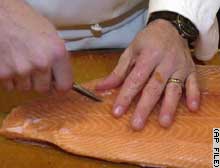Post by Ms. Kathy on Jun 15, 2004 11:43:26 GMT -6
EU sees red over salmon pink
Tuesday, January 28, 2003 Posted: 9:05 AM EST (1405 GMT)

Farmed salmon fillets are set to look less orange
BRUSSELS, Belgium -- A colour additive that turns farmed salmon orange and hens' eggs a deep yellow has been banned by the EU over fears it damages people's eyesight.
The European Union says the pigment canthaxanthin which is used to make farmed products look more attractive is linked to retinal problems in the long term.
It has cut the maximum amount permitted for farmed salmon and chicken feed by at least two-thirds in a ruling that will be effective from December 1 this year.
EU Food Health Commissioner David Byrne was quoted by the UK's Press Association as saying: "Scientific assessments have shown that a high intake of the additive produces an accumulation of pigments in the retina, affecting sight.
"The use of this feed additive is purely cosmetic, to colour food, and reduced levels of it will not adversely affect the taste or quality of our food."
The pigment is used on farmed salmon to turn it from pink to orange, the colour of wild salmon, and to make hens' eggs look more yellow.
Wild salmon gains its orange colour from a diet of shrimp.
Farmers use the pigment because consumers expect it.
But the EU's Scientific Committee on Food decided in 1997 that there was a link between canthaxanthin and retinal problems, and set an "acceptable daily intake" level for the additive of 0.03 milligrams per kilogram of human body weight.
To help keep to this limit, the commission asked animal nutrition experts to review the amounts of the additive going into feed for laying hens and for farmed salmon.
They say the current permitted ceiling of 80 milligrams per kilogram of feed is far too high, and should be slashed to 25 milligrams for salmon and to just eight milligrams for laying hens.
Tuesday, January 28, 2003 Posted: 9:05 AM EST (1405 GMT)

Farmed salmon fillets are set to look less orange
BRUSSELS, Belgium -- A colour additive that turns farmed salmon orange and hens' eggs a deep yellow has been banned by the EU over fears it damages people's eyesight.
The European Union says the pigment canthaxanthin which is used to make farmed products look more attractive is linked to retinal problems in the long term.
It has cut the maximum amount permitted for farmed salmon and chicken feed by at least two-thirds in a ruling that will be effective from December 1 this year.
EU Food Health Commissioner David Byrne was quoted by the UK's Press Association as saying: "Scientific assessments have shown that a high intake of the additive produces an accumulation of pigments in the retina, affecting sight.
"The use of this feed additive is purely cosmetic, to colour food, and reduced levels of it will not adversely affect the taste or quality of our food."
The pigment is used on farmed salmon to turn it from pink to orange, the colour of wild salmon, and to make hens' eggs look more yellow.
Wild salmon gains its orange colour from a diet of shrimp.
Farmers use the pigment because consumers expect it.
But the EU's Scientific Committee on Food decided in 1997 that there was a link between canthaxanthin and retinal problems, and set an "acceptable daily intake" level for the additive of 0.03 milligrams per kilogram of human body weight.
To help keep to this limit, the commission asked animal nutrition experts to review the amounts of the additive going into feed for laying hens and for farmed salmon.
They say the current permitted ceiling of 80 milligrams per kilogram of feed is far too high, and should be slashed to 25 milligrams for salmon and to just eight milligrams for laying hens.

